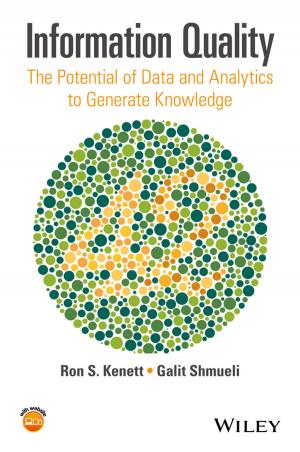Green Chemistry for Dyes Removal from Waste Water
Research Trends and Applications
Nonfiction, Science & Nature, Science, Chemistry, Technical & Industrial| Author: | ISBN: | 9781118721186 | |
| Publisher: | Wiley | Publication: | February 25, 2015 |
| Imprint: | Wiley-Scrivener | Language: | English |
| Author: | |
| ISBN: | 9781118721186 |
| Publisher: | Wiley |
| Publication: | February 25, 2015 |
| Imprint: | Wiley-Scrivener |
| Language: | English |
The use of synthetic chemical dyes in various industrial processes, including paper and pulp manufacturing, plastics, dyeing of cloth, leather treatment and printing, has increased considerably over the last few years, resulting in the release of dye-containing industrial effluents into the soil and aquatic
ecosystems. The textile industry generates high-polluting wastewaters and their treatment is a very serious problem due to high total dissolved solids (TDS), presence of toxic heavy metals, and the non-biodegradable nature of the dyestuffs in the effluent.
The chapters in this book provide an overview of the problem and its solution from different angles. These problems and solutions are presented in a genuinely holistic way by world-renowned researchers. Discussed are various promising techniques to remove dyes, including the use of nanotechnology, ultrasound, microwave, catalysts, biosorption, enzymatic treatments, advanced oxidation processes, etc., all of which are “green.”
Green Chemistry for Dyes Removal from Wastewater comprehensively discusses:
- Different types of dyes, their working and methodologies and various physical, chemical and biological treatment methods employed
- Application of advanced oxidation processes (AOPs) in dye removal whereby highly reactive hydroxyl radicals are generated chemically, photochemically and/or by radiolytic/ sonolytic means. The potential of ultrasound as an AOP is discussed as well.
- Nanotechnology in the treatment of dye removal types of adsorbents for removal of toxic pollutants from aquatic systems
- Photocatalytic oxidation process for dye degradation under both UV and visible light, application of solar light and solar photoreactor in dye degradation
The use of synthetic chemical dyes in various industrial processes, including paper and pulp manufacturing, plastics, dyeing of cloth, leather treatment and printing, has increased considerably over the last few years, resulting in the release of dye-containing industrial effluents into the soil and aquatic
ecosystems. The textile industry generates high-polluting wastewaters and their treatment is a very serious problem due to high total dissolved solids (TDS), presence of toxic heavy metals, and the non-biodegradable nature of the dyestuffs in the effluent.
The chapters in this book provide an overview of the problem and its solution from different angles. These problems and solutions are presented in a genuinely holistic way by world-renowned researchers. Discussed are various promising techniques to remove dyes, including the use of nanotechnology, ultrasound, microwave, catalysts, biosorption, enzymatic treatments, advanced oxidation processes, etc., all of which are “green.”
Green Chemistry for Dyes Removal from Wastewater comprehensively discusses:
- Different types of dyes, their working and methodologies and various physical, chemical and biological treatment methods employed
- Application of advanced oxidation processes (AOPs) in dye removal whereby highly reactive hydroxyl radicals are generated chemically, photochemically and/or by radiolytic/ sonolytic means. The potential of ultrasound as an AOP is discussed as well.
- Nanotechnology in the treatment of dye removal types of adsorbents for removal of toxic pollutants from aquatic systems
- Photocatalytic oxidation process for dye degradation under both UV and visible light, application of solar light and solar photoreactor in dye degradation















